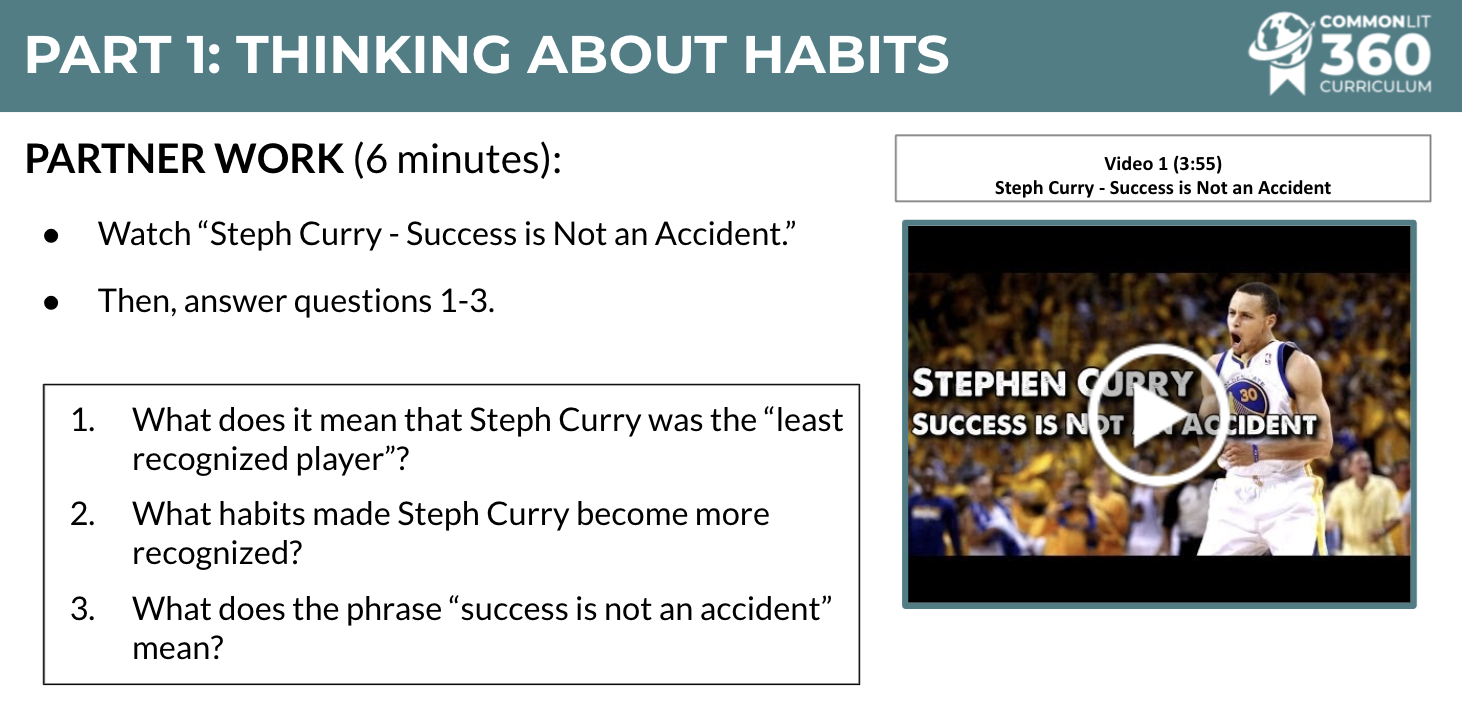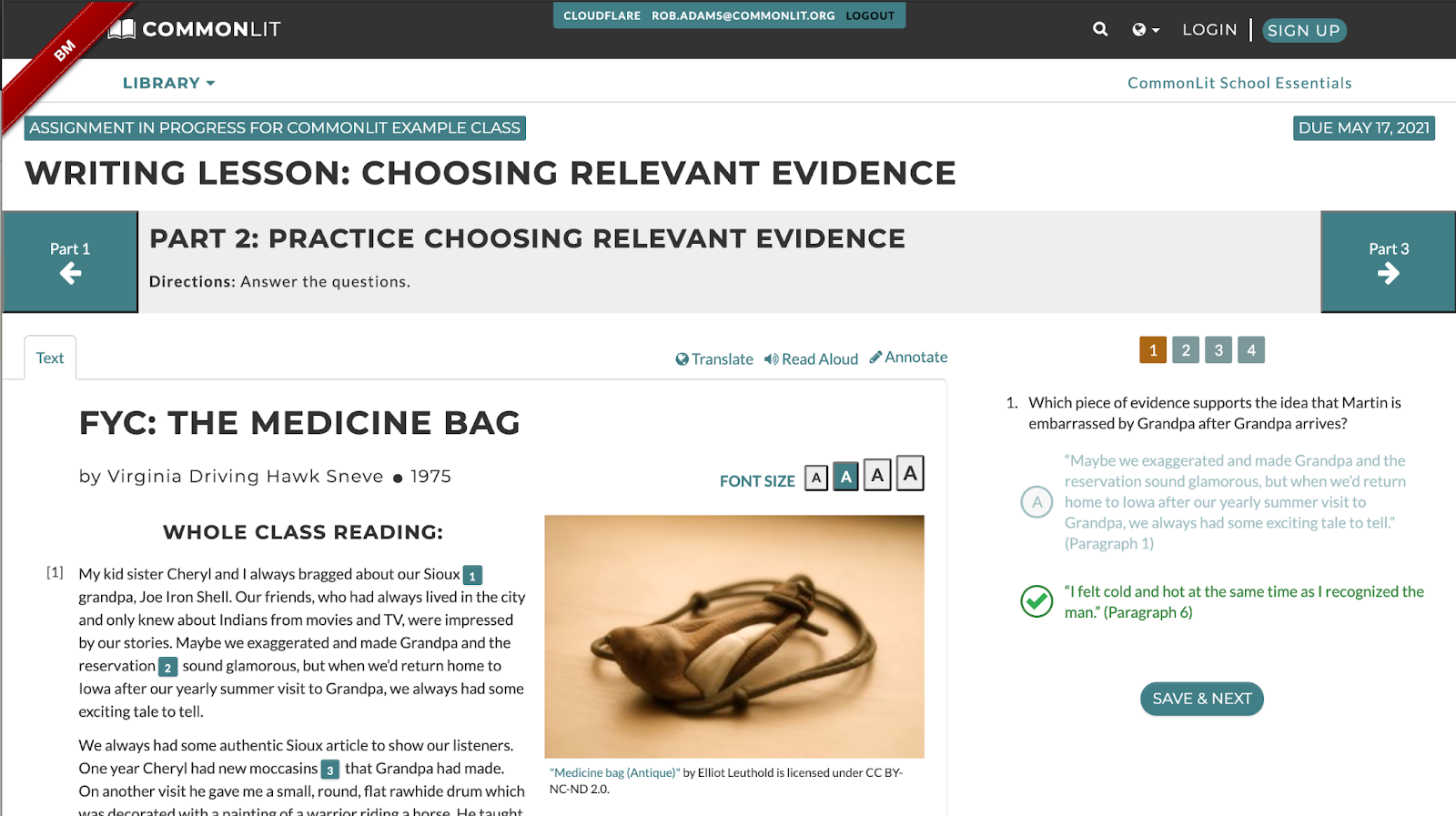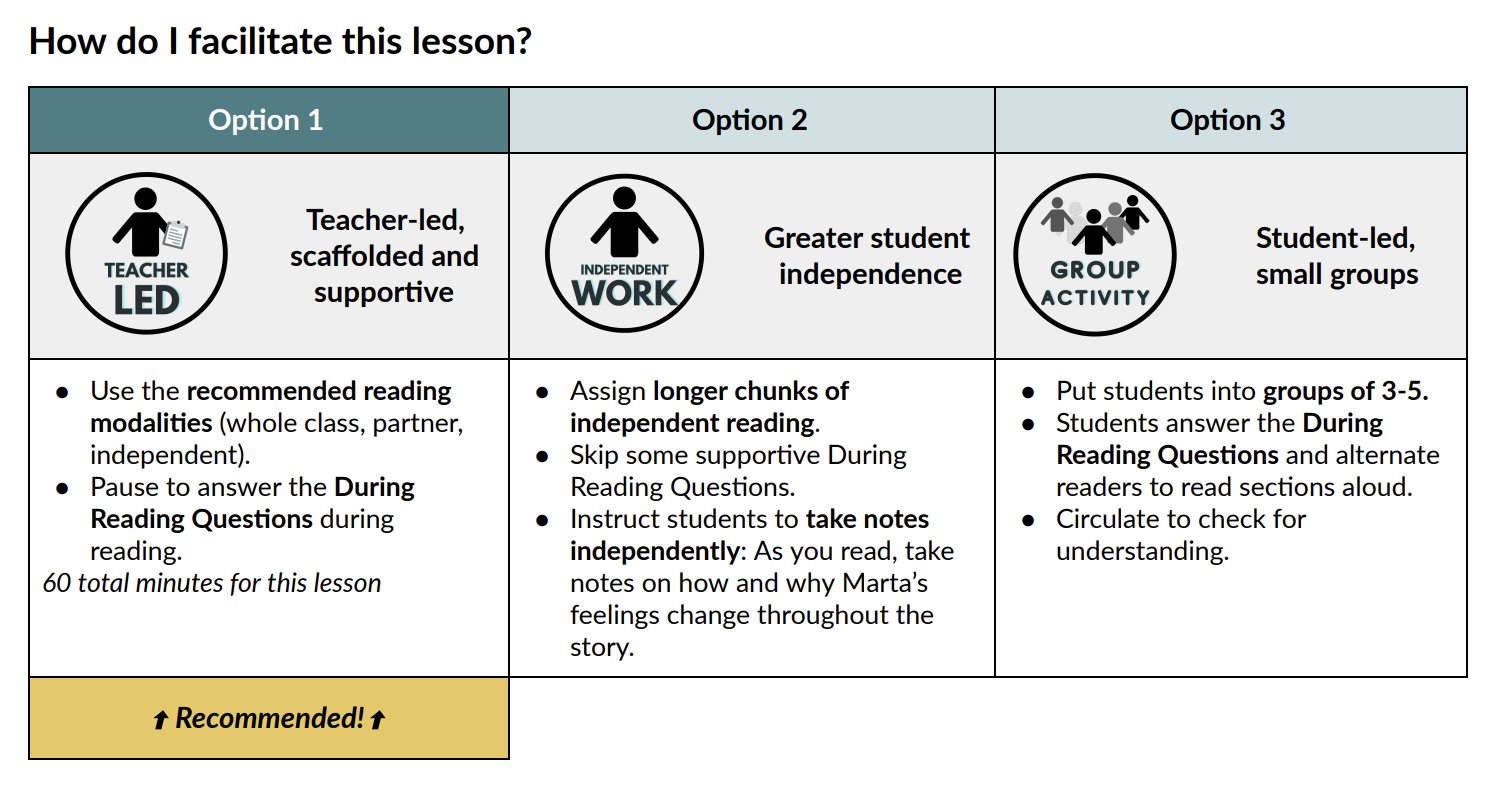CommonLit 360 is a comprehensive ELA curriculum for grades 6-12 that accelerates reading comprehension for struggling readers.
Educators everywhere are thinking about how to maximize instructional time now that students are back in school. What’s the best approach to remediate in ELA instruction, particularly for students who were already behind before the pandemic began?
First, it’s important to keep the research on how students build literacy, knowledge, and language front and center. It can’t be restated enough; what we knew about ELA learning before the pandemic is still true:
- Knowledge-building is key in every grade,
- Language-rich environments foster literacy development,
- Students with learning differences should be included in general education to the maximum extent possible,
- Practice is key. Students need lots of practice to become better readers and writers, and the time spent actually reading and the time spent actually writing matters a lot. For context, the Institute of Education Sciences (IES) recommends 30 minutes a day in writing practice for kindergarteners, and 1 hour per day for first graders.
We also know that the last few years were emotionally challenging for so many students and their families in ways that profoundly transcend a 45-minute ELA block. As educators, we’re in uncharted territory when it comes to our students’ social-emotional well being, and to ignore that would be grossly irresponsible.
So, given all this, what’s our best recommendation for an approach to address “learning loss” in the ELA classroom post-pandemic? And how can CommonLit help?
One timely tool that could be transformative is CommonLit’s comprehensive curriculum for grades 6-12: CommonLit 360. CommonLit 360 is the first curriculum of its kind to be available on an interactive digital platform. It’s a culmination of 3 years of work and pilots in 50 schools nationally. Although we started the development of 360 before the pandemic began, we intentionally designed the lessons to be relevant, supportive, and highly engaging for students. CommonLit 360 is freely available to every educator with a CommonLit account, including ready-to-use units with engaging informational and literary texts from our digital library.
Here are some of the ways that CommonLit 360 could be a great fit for schools looking to meet the joint goals of maximizing instructional time and building reading comprehension while attending to students’ social-emotional needs post-pandemic:
Rebuild trust and community through shared reading
This is my biggest recommendation about how to approach reading intervention and literacy instruction post-pandemic: start with shared texts. After so much social isolation, what could be better than sitting down to experience the gift of getting lost in a great story with your classmates and teacher?
CommonLit 360 is built around shared texts and shared classroom experiences. The curriculum materials are packed with differentiation tools, but it is not a computerized program where kids work independently on siloed tracks. Instead, CommonLit 360 is built around creating an inclusive learning environment for students with learning differences, a best practice (Hehir & Katzman, 2012). Unit 1 of our ELA curriculum kicks off with high interest character-driven short stories. Reading lessons are designed so that students experience the twists and turns of the stories together as a class. What’s more, the texts in our 360 units were selected with care and intention, representing a diverse range of voices and protagonists. What a great way to bring joy into the classroom!

Provide regular opportunities for students to work collaboratively
We’ve all seen the heartbreaking effects of social isolation on our kids. This isolation was extremely difficult on teenagers, who are in those precious years of their lives during which they are developing the social areas of their brains (Blakemore & Choudhury, 2006). Teenagers are social beings. It turns out that there is a scientific reason why middle and high schoolers respond so well to collaborative pedagogical techniques!
CommonLit 360 units for grades 6–12 are built to maximize valuable student-to-student interactions, and help students build the confidence to become active in their classroom through authentic dialogue, group work, and research projects.
We know that planning for group work can be tricky; our materials take the headache out of the equation. For example, 360 units include ready-made Related Media Explorations that teachers can facilitate (or students can lead) in pairs or small groups. These explorations help to build essential background knowledge on the major themes in the unit. CommonLit 360 Units are also rich with discussion questions and discussion lessons, aimed at getting students thinking and talking about academic content with their peers, another best practice (Applebee, 2003).

Build language through explicit vocabulary instruction
In keeping with the theme of maximum inclusion, one of the best practices that has shown to help all students, but especially English Language Learners, is explicit vocabulary instruction (Lesaux, 2010). The best practice is to teach words that are high-utility, meaning that students will likely see the words a lot in their academic careers, in math and ELA — words like “associate.” We know from the research that students need multiple exposures to new words in context to make them “stick.” We also know that when it comes to word knowledge, success begets success; students who know more words are able to read harder texts with more confidence, and students who read harder texts with more confidence learn more words. This is exactly the kind of momentum we need.
Every CommonLit 360 unit includes a set of Tier 2 academic vocabulary words that have been hand-picked from the texts that anchor each unit. We provide a set of five activities for every set of words, and a vocabulary quiz to assess word knowledge. What’s more, students get exposed to the words over and over again in the unit; they see them in the text, in questions, and they are prompted to use them in classroom discussions and written responses. We even provide a ready-made word wall — all you have to do is press “print.”

Normalize “failure,” and create a safe, practice rich environment
Some of the best teachers I’ve ever observed in my career are ones that make students feel inspired to take on difficult cognitive tasks with greater and greater energy and enthusiasm. They did this by creating an environment where students get multiple “at bats” with new skills, and where practice, failure, and feedback was part of a normal routine. Questions weren’t a rare “gotcha” moment; they were constant and part of learning, and students felt safe and supported when they swung and missed. When students were ultimately successful, it was because they took an intellectual risk and got rewarded with a boost of confidence.
When we wrote CommonLit 360, we had this kind of supportive, practice-rich classroom environment in mind. CommonLit 360 lessons are filled with scaffolded questions and accessibility tools that help give students many “at bats” with skills and content. Every reading lesson includes a set of guided reading questions designed to build student reading comprehension. Students stop and write, turn and talk, and share their ideas with their peers while they read. It’s a great way to keep momentum going in a supportive way. Anecdotally, we’ve seen students in our pilot classrooms develop a sense of safety and calm because they can anticipate these classroom routines.

Add a personal touch to build authentic relationships with students
One thing that the pandemic underscored is the role that teachers play in our kids’ lives. It isn’t a purely academic role; teachers are people that our kids watch and emulate. Great teachers have authentic relationships with our kids and motivate them to be their best. One way to build these relationships is through the curriculum itself; teachers who embrace the curriculum, make it their own, and adapt it to the needs of their students are far more effective.
CommonLit 360 was designed to be flexible while offering a strong curricular foundation for teachers. The materials include ready-made teacher and student materials, but the lessons are not so scripted as to be stifling. Our theory is that by saving teachers hours in planning, we are freeing up time for teachers to add those personal elements and be more responsive to the needs of students.
CommonLit 360 is also an openly-licensed curriculum; unless otherwise noted, materials are licensed under CC BY NC SA 4.0, which means that they are available for remix and reuse for educational purposes. In fact, most of the 360 materials are available in editable Google Docs versions, which makes the lessons themselves easy to adapt. In short, we understand the unique touch that teachers bring to their lessons, and how powerful it can be when teachers are supported with high-quality materials.

Ready to learn more about CommonLit 360?
- Browse the CommonLit 360 units here.
- Sign up for a CommonLit 360 webinar to get started with the curriculum and learn all about the units & new lesson types.
- Check out the CommonLit 360 Curriculum Overview document with more. information about the scope and sequence, design principles, and moreLearn about the affordable wraparound services for schools and districts looking to adopt CommonLit 360.

